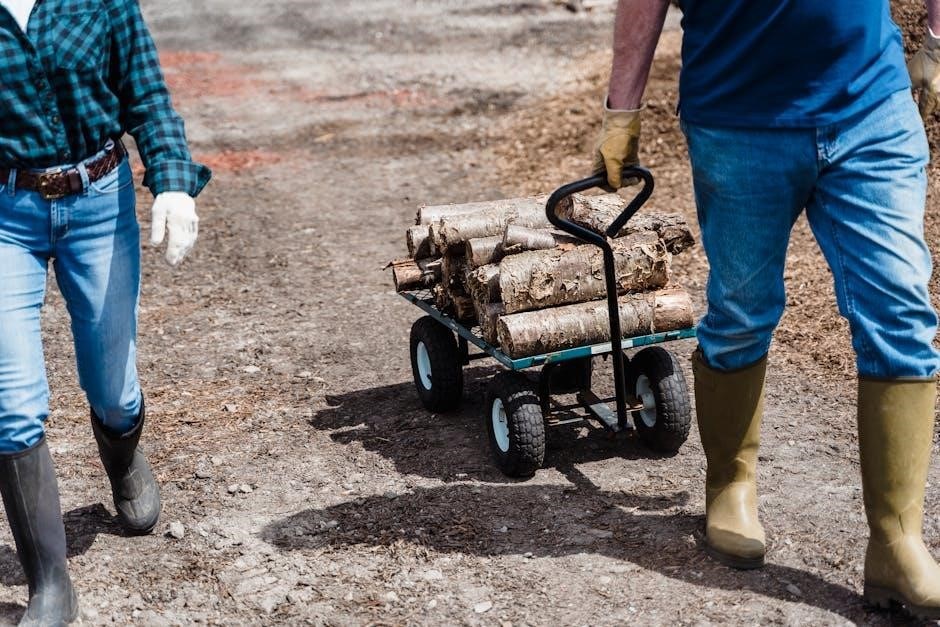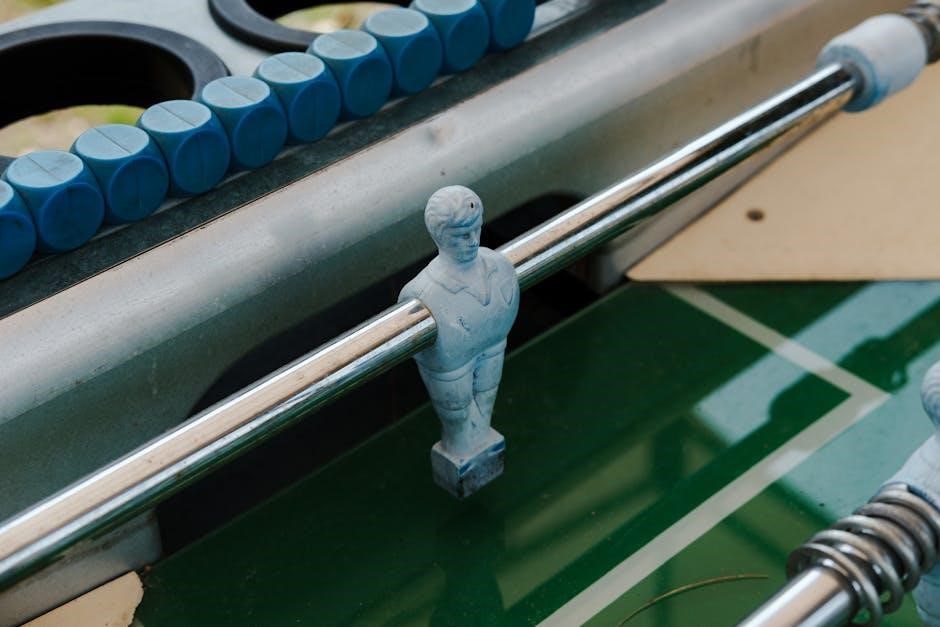wagon manual
A wagon manual provides comprehensive guidance on the design, functionality, and operation of horse-drawn vehicles, ensuring safe and efficient use for transportation and agricultural purposes.
Overview of Wagon History and Evolution
The history of wagons dates back to ancient times, with early versions emerging as four-wheeled, horse-drawn vehicles used for transportation and cargo. The earliest known wagons were developed around the 1st century BC, incorporating innovations like spoked wheels and metal rims. Over centuries, wagons evolved to serve diverse purposes, from agriculture to ceremonial events. Regional variations in design reflected local materials and cultural needs, with some wagons built for heavy loads and others for passenger transport. The evolution of wagons mirrors technological advancements and societal demands, showcasing their pivotal role in history. Their enduring presence highlights their adaptability and enduring utility in both practical and recreational contexts.
Purpose and Functionality of a Wagon Manual
A wagon manual serves as an essential guide for understanding the construction, maintenance, and operation of horse-drawn vehicles. It provides detailed insights into the historical development of wagons, their design variations, and practical applications. The manual addresses key aspects such as materials used in construction, suspension systems, and wheel axle designs. It also offers guidance on safe load management, proper harnessing of draft animals, and emergency procedures. Additionally, the manual covers maintenance tasks and repair techniques, ensuring optimal performance and longevity of the wagon. Whether for agricultural use, ceremonial purposes, or recreational activities, the manual is a vital resource for anyone involved with wagons, offering both historical context and practical advice.

Historical Overview of Wagons
Wagons originated in ancient times, evolving from early chariots and carts, becoming essential for transportation and societal progress across various regions and historical periods.
Early Development of Four-Wheeled Horse-Drawn Vehicles
The four-wheeled horse-drawn vehicle emerged as a refinement of earlier two-wheeled chariots, with the first recorded use dating back to the 1st century BC. These early wagons featured spoked wheels and metal rims, enhancing durability and mobility. By the 13th century, the chariot evolved into a four-wheeled design, marking a significant milestone in transportation technology. Wagons became indispensable for both passenger transport and cargo hauling, playing a crucial role in agriculture and trade. Their design varied across regions, adapting to specific needs, but the core concept of a sturdy, four-wheeled frame pulled by draft animals remained consistent, laying the foundation for modern horse-drawn vehicles.
Role of Wagons in Transportation History
Wagons have played a pivotal role in shaping transportation history, serving as essential tools for moving goods and people across various regions. From agricultural products to heavy cargo, wagons facilitated trade and economic growth, connecting communities and industries. In regions like Australia, horse-drawn vehicles such as the Cobb & Co Coach and bullock drays were instrumental in colonial development. Wagons also supported military operations and ceremonial events, showcasing their versatility. Their widespread use declined with the advent of motorized vehicles, but their historical significance remains profound, highlighting their enduring impact on societal progress and cultural heritage.
Regional Variations in Wagon Design
Wagon designs have varied significantly across regions, reflecting local needs, materials, and cultural influences. In Australia, the Cobb & Co Coach and bullock drays were integral to colonial transportation, while European regions developed carriages and carts tailored for specific tasks. The use of wood, steel, and leather in construction differed by area, with some regions favoring durability for heavy loads and others prioritizing elegance for ceremonial purposes. Custom builders, like Hansen Wheel and Wagon Shop, highlight regional craftsmanship in creating wagons for historical sites and enthusiasts. These variations underscore how wagons were adapted to serve diverse purposes, from agriculture to recreation, across the globe.

Design and Construction of Wagons
Wagon design incorporates wood, steel, and leather, focusing on durability and functionality. Construction emphasizes sturdy frameworks, efficient suspension systems, and customizable features to meet specific transportation needs effectively.
Key Materials Used in Wagon Construction
Traditional wagon construction relies on durable materials such as wood, steel, and leather. Wood provides a lightweight yet sturdy framework, while steel is used for axles and wheel rims for strength. Leather is incorporated into harnesses and seats for comfort and flexibility. Additionally, galvanized metal components are often used to enhance rust resistance and longevity. These materials are carefully selected to ensure the wagon’s structural integrity and performance, making it suitable for various applications, from agricultural use to ceremonial purposes. The combination of these elements ensures a balance between functionality and aesthetic appeal, preserving the timeless design of horse-drawn wagons.
Understanding Wagon Suspension Systems
Wagon suspension systems are designed to absorb shocks and provide stability, ensuring a smooth ride over uneven terrain. These systems typically consist of leather straps, metal components, or wooden frames that connect the wagon body to the axles. The suspension allows for vertical movement, reducing the impact of bumps on passengers and cargo. Properly maintained suspension systems are crucial for extending the lifespan of the wagon and ensuring safe operation. Regular lubrication of moving parts and alignment of wheels are essential maintenance tasks. A well-functioning suspension system not only enhances comfort but also improves the overall performance of the wagon, making it suitable for various applications, from agriculture to transportation.
Importance of Wheel and Axle Design
The design of wheels and axles is critical to a wagon’s functionality, as it directly impacts stability, load capacity, and maneuverability. The axle serves as the central component, supporting the weight and distributing it evenly across the wheels. Larger wheels improve mobility over rough terrain, while narrower wheels are better suited for smooth surfaces. The material and construction of the axle and wheels, such as wood or steel, determine durability and weight-bearing capacity. Proper alignment and balance ensure smooth operation and prevent wear. Historical designs often featured iron rims for added strength, while modern adaptations may incorporate advanced materials for enhanced performance. The wheel and axle system remains a cornerstone of wagon design, ensuring efficient and reliable transportation.

Types of Wagons
Wagons vary widely, including farm wagons for agriculture, horse-drawn carriages for transport, and specialized designs for heavy loads, each tailored to specific tasks and environments.
Farm Wagons and Their Uses
Farm wagons are essential tools in agriculture, designed for hauling crops, equipment, and livestock. Built with durable materials like wood and steel, they offer versatility and strength. These wagons are typically four-wheeled, providing stability for heavy loads. Farmers use them for transporting hay, grains, and tools across fields. Some models feature removable sides for easy loading and unloading. Farm wagons are also used for livestock transport, ensuring safe and efficient movement. Their robust design makes them ideal for rough terrain, supporting daily farm operations. Whether for small-scale or large agricultural needs, farm wagons remain indispensable, showcasing their practicality and enduring value in rural settings.
Horse-Drawn Carriages and Their Variations
Horse-drawn carriages are elegant, two- or four-wheeled vehicles designed for transporting passengers. Historically, they were a symbol of wealth and status, offering comfort and style. Variations include phaetons, broughams, and stagecoaches, each serving different purposes. Phaetons are light and fast, while stagecoaches are built for long-distance travel. Constructed from wood, steel, and leather, these carriages combine durability with aesthetic appeal. Today, they are used in ceremonies, parades, and tourism, preserving their cultural heritage. Despite modern transportation, horse-drawn carriages remain popular for recreational and symbolic purposes, embodying a timeless blend of tradition and craftsmanship.
Specialized Wagons for Heavy Loads
Specialized wagons are designed to handle heavy loads, featuring reinforced frames and sturdy materials for durability. Constructed with wood, steel, and metal rims, these wagons are ideal for agricultural and industrial tasks. They often include larger wheels and stronger axles to distribute weight evenly, ensuring stability. Variations like freight wagons and platform wagons cater to specific needs, such as hauling bulky goods or construction materials. Their robust design allows them to operate efficiently in challenging environments, making them essential for industries requiring reliable transportation solutions. These wagons exemplify the evolution of traditional craftsmanship to meet modern demands for strength and performance.

Operational Aspects of Wagons
Operational aspects of wagons involve proper handling of draft animals, load management, and driving techniques, ensuring efficient and safe transportation with balance and control.
How to Properly Harness and Handle Draft Animals
Properly harnessing and handling draft animals is essential for safe and efficient wagon operation. Begin by ensuring the harness fits comfortably, with padding to prevent chafing. The collar should sit snugly, and traces should be adjusted to distribute weight evenly. Lead lines must be held firmly but gently, allowing clear communication with the animals. Always approach the animals calmly and use consistent commands to avoid startling them. Regular grooming and inspections are crucial to maintain their health and performance. Proper handling ensures the animals’ well-being and optimal wagon functionality, making the task enjoyable and productive for both the handler and the draft team.
Techniques for Safe and Effective Load Management
Safe and effective load management is critical for maintaining control and ensuring the longevity of the wagon. Always distribute weight evenly to prevent imbalance, securing items firmly to avoid shifting during transit. Overloading can strain the draft animals and compromise safety, so adhere to recommended capacity limits. Use appropriate straps or ropes to tie down cargo, protecting both the load and the wagon. Balancing heavy and light items strategically minimizes the risk of tipping. Regularly inspect the load for stability and make adjustments as needed. Proper load management not only safeguards the wagon and its contents but also ensures the well-being of the draft animals, promoting efficient and secure transportation. Avoid overloading to maintain control and prevent potential hazards.
Driving and Control Mechanisms of Wagons
Driving and controlling a wagon requires skill and attention to detail. The primary mechanism involves the use of reins to guide the draft animals, ensuring precise directional control. A balanced posture and firm grip on the reins help maintain stability. Brake systems, often operated by foot or hand, are essential for slowing down or stopping, especially on inclines. Effective communication with the animals, through verbal commands or physical cues, enhances responsiveness. Proper alignment of the wagon wheels with the direction of travel minimizes resistance. Regular inspection of the control mechanisms, such as reins and brakes, ensures reliability. Practicing in open spaces and gradually mastering turns and stops is crucial for safe operation. Experience and coordination are key to handling various terrains and loads efficiently.

Safety Measures and Precautions
Ensure proper harnessing, balanced load distribution, and regular inspections of wagon components to prevent accidents and maintain control while operating horse-drawn vehicles.
Common Hazards Associated with Wagon Use
Common hazards include loss of control due to improper harnessing, collisions with parked vehicles, and accidents caused by startled animals. Regular inspections of wagon components and balanced load distribution are crucial to minimize risks. Additionally, ensuring proper training for handlers and maintaining safe speeds can prevent mishaps. Accidents often occur when horses are spooked or when loads shift unexpectedly, emphasizing the need for vigilant monitoring and adherence to safety protocols. Proper maintenance of wheels and axles is also essential to avoid mechanical failures during operation. By addressing these hazards, users can enhance safety and ensure smooth functionality of horse-drawn wagons.
Best Practices for Maintaining Wagon Safety
Regular inspections of wagon components, such as wheels, axles, and harnesses, are essential to ensure reliability. Proper load balancing and secure fastening of cargo help prevent shifting during transit. Drivers should be trained in handling draft animals and emergency procedures. Wearing protective gear, like gloves and sturdy footwear, is recommended. Maintaining a safe distance from other vehicles and pedestrians is crucial, especially in urban areas. Clear communication between handlers and consistent commands for animals can prevent accidents. Regular lubrication of moving parts and timely replacement of worn elements are vital for smooth operation. Adhering to these practices minimizes risks and ensures a safe experience for both users and bystanders.
Emergency Procedures in Case of Accidents
In the event of an accident involving a wagon, prioritize safety by remaining calm and assessing the situation. Secure the area to prevent further incidents and ensure the safety of passengers, animals, and bystanders. Immediately report the incident to local authorities and provide first aid if necessary. Move injured individuals to a safe location and avoid moving the wagon unless it poses a hazard. Document the incident with photos and details for insurance or legal purposes. Tend to injured animals and seek veterinary assistance if needed. Contact professionals for wagon recovery or repairs. Finally, review the incident to identify preventive measures for future incidents.

Maintenance and Repair of Wagons
Regular lubrication of axles, inspection of wheels, and tightening of joints ensure optimal wagon performance. Repairs involve restoring wooden and metal parts, while restoration preserves historical authenticity and functionality.
Regular Maintenance Tasks for Optimal Performance
Regular maintenance is crucial for ensuring wagons operate efficiently and safely. Essential tasks include lubricating axles, inspecting and tightening wheel hubs, and checking the condition of wooden and metal components. Wheels and axles should be greased periodically to prevent wear and tear. Additionally, the frame and joints must be examined for any signs of damage or loosening. Proper care extends the lifespan of the wagon and ensures smooth operation. Schedule inspections before and after heavy use to identify potential issues early. Addressing minor repairs promptly prevents more extensive damage over time, maintaining the wagon’s reliability and performance.
Repair Techniques for Worn or Damaged Parts
Repairing worn or damaged wagon parts requires careful assessment and precise techniques. For wooden components, replacing rotted sections with durable, treated wood is essential. Metal parts, such as axles and rims, should be inspected for cracks or rust and replaced if necessary. Lubrication of moving parts, like wheel bearings, prevents further wear. When restoring historical wagons, traditional methods and materials are often preferred to maintain authenticity. Professional craftsmanship may be needed for intricate repairs. Always ensure that repairs align with the wagon’s original design to preserve functionality and structural integrity. Regular inspections help identify issues early, making repairs more manageable and cost-effective.
Restoration of Historical or Antique Wagons
Restoring historical or antique wagons requires meticulous attention to detail and a deep understanding of traditional craftsmanship. The process involves preserving original materials while replacing deteriorated parts with historically accurate alternatives. Wood, metal, and leather components are carefully refurbished or replicated to maintain authenticity. Specialized workshops and skilled artisans often handle complex restorations, ensuring that the wagon’s historical integrity is preserved. Techniques such as hand-carving, blacksmithing, and traditional joinery are employed to replicate original designs. The goal is to restore functionality while honoring the wagon’s cultural and historical significance. Proper documentation and research are essential to ensure accuracy. Restored wagons often become prized possessions, serving as living reminders of the past.

Cultural and Historical Significance
Wagons have profoundly shaped societies, facilitating transportation, agriculture, and trade. Their enduring presence in ceremonies and traditions underscores their cultural and historical importance, embodying human ingenuity and resilience.
Wagons in Ceremonial and Recreational Use
Wagons have long been integral to cultural and recreational activities, symbolizing tradition and heritage. They are often used in ceremonies, such as weddings and parades, adding elegance and historical charm. In recreational settings, horse-drawn wagons provide unique experiences, like hayrides and sightseeing tours, connecting people to the past. Their versatility allows them to serve as platforms for historical reenactments, festivals, and fairs, preserving cultural practices. Additionally, wagons are popular in horse shows and competitions, showcasing craftsmanship and skill. Their enduring appeal in both ceremonial and recreational contexts highlights their significance as vessels of tradition and enjoyment, bridging the gap between history and modern leisure.
Impact of Wagons on Agricultural Development
Wagons played a pivotal role in advancing agriculture by enabling efficient transportation of goods and equipment. Their sturdy design allowed farmers to haul heavy loads, such as crops and machinery, over long distances. This facilitated the expansion of farmlands and increased productivity, contributing to food security and economic growth. Wagons also served as mobile workstations, providing a reliable means to carry tools and supplies to remote fields. Their versatility supported various farming activities, from planting to harvesting, making them indispensable in rural economies. By streamlining agricultural logistics, wagons were instrumental in the development of modern farming practices, ensuring sustainable food production and rural prosperity.
Wagons in Modern Transportation and Tourism
Despite advancements in technology, wagons remain relevant in modern transportation and tourism, offering a nostalgic and charming experience. Many companies specialize in custom-building horse-drawn wagons for historical reenactments, parades, and tourist attractions. These vehicles are often used in recreational activities, such as hayrides, festivals, and guided tours, providing a unique way to connect with the past. In some regions, wagons are still employed for local transportation, particularly in rural or scenic areas. Their enduring appeal lies in their historical significance and the ability to evoke a sense of tradition and simplicity. This blend of practicality and cultural value ensures wagons continue to play a role in modern society, both as functional tools and symbols of heritage.
The wagon manual serves as a vital resource, offering insights into the history, design, and operation of wagons, ensuring their continued relevance in modern and traditional contexts alike.
Future of Wagons in a Modern World
While wagons have historically been central to transportation and agriculture, their role in the modern world is evolving. Advances in materials and technology are enabling the creation of lightweight, durable wagons that blend traditional craftsmanship with contemporary needs. Companies like Hansen Wheel and Wagon Shop are leading the way, offering custom-built wagons for historical preservation and enthusiast use. Additionally, wagons are finding new purposes in eco-friendly tourism, cultural ceremonies, and niche agricultural applications. As sustainability becomes a global priority, the humble wagon may see a resurgence as a practical, low-carbon transportation solution, ensuring its relevance for generations to come.
Final Thoughts on the Importance of Wagon Manuals
Wagon manuals are indispensable resources for understanding and maintaining these versatile vehicles. They provide detailed insights into construction, operation, and safety, ensuring users can maximize functionality while minimizing risks. Whether for historical preservation or modern applications, manuals serve as a bridge between traditional craftsmanship and contemporary practices. By adhering to the guidelines outlined in these manuals, enthusiasts and professionals alike can uphold the integrity and performance of wagons. Their importance extends beyond practicality, preserving the heritage of horse-drawn transportation for future generations to appreciate and utilize effectively.